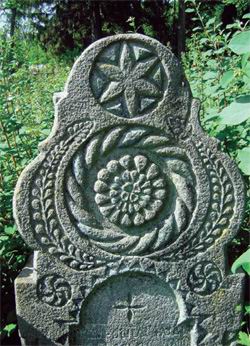Ján Aláč
Stone tombstones marking the graves of Lutherans of the Augsburg Confession and dating from the end of the nineteenth and first decades of the twentieth century are a unique demonstration of folk art and creativity in the northwest part of Novohrad (a region of south Slovakia). Several trends are joined into one when creating them. The first one is the overall inclination of that period to increased decorativeness. Further, it is the confession of the inhabitants of this region determining the form and shape. The third is the growth of stone masonry, which can be noted in the whole country from the second half of the nineteenth century due to the increased endeavour of creating infrastructure – roads, bridges and railways. The tombstone’s creator was not a professional stone mason. Creating them was merely an additional activity along with traditional agriculture. The appearance of tombstones in Novohrad in many ways talks about the period, patterns and symbols that dominated. They are only memories to remember the whole which in its pretended simplicity and monotony was more colourful than one could see at first sight. It was not a static picture, even though burial customs are the most conservative customs of all folk traditions. The appearance of tombstones was in practice constantly changing. Since the end of nineteenth up to mid twentieth century, when we can still talk about folk tombstone creation, one can find seven or eight developments in stone tombstones. Tombstones are really a stone database of the signs and symbols concentrated in the small area of the cemetery. In this sense, it is valid to talk about cemeteries as places of collective memory. Ornamental decoration is full of signs and symbols whose original sense was in time reduced to a level of decorativeness; however, at the turn of the nineteenth and twentieth centuries it still remained, even if only in fragments or under the influence of tradition. From the beginning of the twentieth century, the mass of the tombstone is significantly decreased and the decorativeness is reduced.
